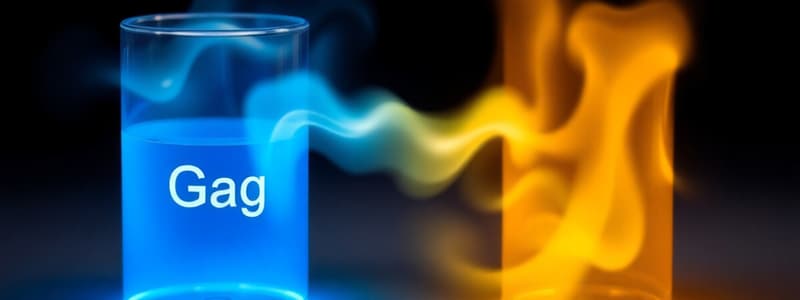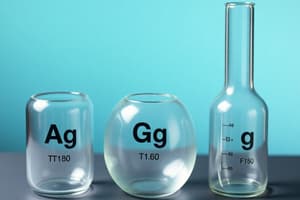Podcast
Questions and Answers
According to Boyle's Law, what happens to the pressure of a gas if its volume is halved, assuming constant temperature?
According to Boyle's Law, what happens to the pressure of a gas if its volume is halved, assuming constant temperature?
- The pressure is halved.
- The pressure increases by a factor of four.
- The pressure doubles. (correct)
- The pressure remains the same.
The SI unit for pressure is the Newton (N).
The SI unit for pressure is the Newton (N).
False (B)
What is the standard temperature and pressure (STP) for gases?
What is the standard temperature and pressure (STP) for gases?
273.15 K and 100 kPa
Real gases deviate from ideal gas behavior at ______ temperatures and ______ pressures.
Real gases deviate from ideal gas behavior at ______ temperatures and ______ pressures.
Match the following pressure units with their abbreviations:
Match the following pressure units with their abbreviations:
The collisions between gas molecules in an ideal gas model are perfectly elastic, meaning no energy is lost from the system.
The collisions between gas molecules in an ideal gas model are perfectly elastic, meaning no energy is lost from the system.
The ______ of an ideal gas is a constant at a specific temperature and pressure.
The ______ of an ideal gas is a constant at a specific temperature and pressure.
Which of the following is NOT a key assumption of the ideal gas model?
Which of the following is NOT a key assumption of the ideal gas model?
Why do real gases deviate from the ideal gas model at low temperatures and high pressures?
Why do real gases deviate from the ideal gas model at low temperatures and high pressures?
Match the following characteristics to their corresponding ideal gas model assumption:
Match the following characteristics to their corresponding ideal gas model assumption:
Give one example of how real gases deviate from the ideal gas model.
Give one example of how real gases deviate from the ideal gas model.
The ideal gas equation, PV=nRT, describes the relationship between pressure, volume, temperature, and amount of an ideal gas.
The ideal gas equation, PV=nRT, describes the relationship between pressure, volume, temperature, and amount of an ideal gas.
Which of the following conditions would make a real gas behave more like an ideal gas?
Which of the following conditions would make a real gas behave more like an ideal gas?
Flashcards
Boyle's Law
Boyle's Law
At constant temperature, pressure is inversely proportional to volume.
SI Unit of Pressure
SI Unit of Pressure
The standard unit of pressure is Pascal (Pa), equivalent to N/m² or J/m³.
Standard Temperature and Pressure (STP)
Standard Temperature and Pressure (STP)
STP for gases is 273.15 K and 100 kPa.
Real vs Ideal Gas
Real vs Ideal Gas
Signup and view all the flashcards
Intermolecular Forces Impact
Intermolecular Forces Impact
Signup and view all the flashcards
Ideal Gas
Ideal Gas
Signup and view all the flashcards
Assumptions of Ideal Gas Model
Assumptions of Ideal Gas Model
Signup and view all the flashcards
Elastic Collisions
Elastic Collisions
Signup and view all the flashcards
No Intermolecular Forces
No Intermolecular Forces
Signup and view all the flashcards
Kinetic Energy and Temperature
Kinetic Energy and Temperature
Signup and view all the flashcards
Molar Volume
Molar Volume
Signup and view all the flashcards
Ideal Gas Equation
Ideal Gas Equation
Signup and view all the flashcards
Real Gases vs Ideal Gases
Real Gases vs Ideal Gases
Signup and view all the flashcards
Study Notes
Ideal Gas
- An ideal gas is composed of particles with negligible volume and no intermolecular forces.
- All collisions between particles are considered elastic.
- Real gases deviate from ideal behavior, especially at low temperatures and high pressures.
Ideal Gas Model Assumptions
- Constant random motion: Gas molecules move constantly in straight lines until colliding with each other or the container walls.
- Perfectly elastic collisions: Collisions between molecules do not result in any energy loss.
- No intermolecular forces: Forces of attraction between gas particles are negligible compared to their kinetic energy.
Ideal Gas Model Assumptions (continued)
- Negligible particle volume: The volume occupied by the gas particles themselves is much smaller than the container's volume.
- Kinetic energy and temperature: The kinetic energy of gas particles is directly proportional to the Kelvin temperature.
Pressure-Volume Relationships
- Boyle's Law: At constant temperature, the pressure of a fixed amount of gas is inversely proportional to its volume (pV = constant).
- Doubling the pressure of a gas, at a constant temperature, will halve its volume.
Pressure-Volume Relationships (continued)
- Graphs illustrating the relationship between pressure and volume in an ideal gas show an inverse relationship.
- Standard Temperature and Pressure (STP): 273.15 K and 100 kPa
Worked Example 1
- A weather balloon filled with 32.0 dm³ of helium at 100.0 kPa pressure at sea level.
- Reaches an altitude of 4500 m where atmospheric pressure is 57.7 kPa.
- The volume of the balloon at this altitude (assuming constant temperature) is approximately 55.5 dm³.
Practice Question 1
- A weather balloon at a certain altitude has a temperature of -35.0°C and a volume of 0.250 m³.
- The balloon contains 16.0 g of helium
- Calculate the pressure inside the balloon in kPa.
- Answer: 31.7 kPa
Real Gases vs Ideal Gases
- Deviation from ideal gas behavior arises when intermolecular forces become significant or when gas particle volume is no longer negligible.
- At low temperatures or high pressures, these conditions are often met.
Real Gases vs Ideal Gases (continued)
- The kinetic energy of gas molecules is reduced at low temperatures, increasing intermolecular forces.
- High pressures increase the proportion of space taken up by gas molecules. The volume of the molecules becomes significant compared to the space between them
Ideal Gas Conditions
- Low pressure and high temperature lead to ideal gas behavior.
- At low pressure, the space between molecules is large compared to the volume of the molecules themselves.
- High temperatures give gas particles enough kinetic energy to overcome intermolecular forces.
The Molar Volume of an Ideal Gas
- Equal volumes of any two gases, at the same temperature and pressure, contain equal numbers of particles.
- The molar volume of an ideal gas at STP (standard temperature and pressure) is 22.7 dm³.
Worked Example 2
- A 2.00 dm³ sample of an unknown gas at STP (standard temperature and pressure) has a mass of 2.47 g.
- Calculate the molar mass of the gas.
- Answer: 28.0 g/mol
Practice Question 2
- Determine the molar mass of an elemental diatomic gas with a density of 3.12 g/dm³ at STP.
- Answer: 70.9 g/mol; Cl₂
Combined Gas Law
- The combined gas law describes the relationship between pressure, volume, and temperature of a fixed amount of gas.
- pV/T = constant
- This can be used to relate properties at different conditions.
Worked Example 3
- Illustrates determining the volume of an ideal gas sample under altered pressure and temperature conditions from starting conditions, using combined gas law
Practice Question 3
- Calculate the volume in dm³ of an ideal gas sample with starting conditions of 1.00 dm³ at STP
- To be changed to conditions of 50.0°C and 50.0 kPa
Ideal Gas Equation
- The ideal gas equation (pV = nRT) relates pressure (p), volume (V), amount (n), temperature (T), and universal gas constant (R).
- Ideal gas law used to determine gas properties from others
Worked Example 4
- A 3.30 g sample of an unknown organic compound was vaporized at 150°C and 101.3 kPa to produce 1.91 dm³ of gas.
- The gas was combusted to produce...
- Determine the molar mass, empirical formula and molecular formula
Studying That Suits You
Use AI to generate personalized quizzes and flashcards to suit your learning preferences.



